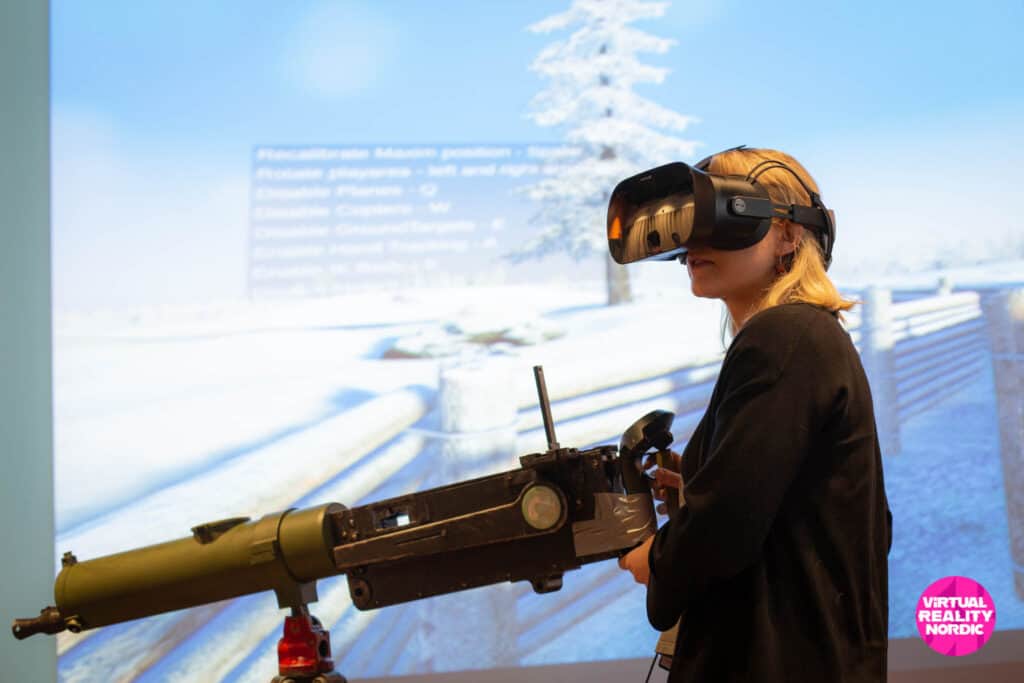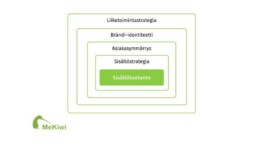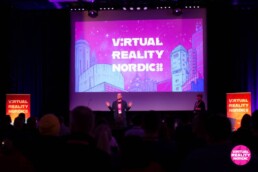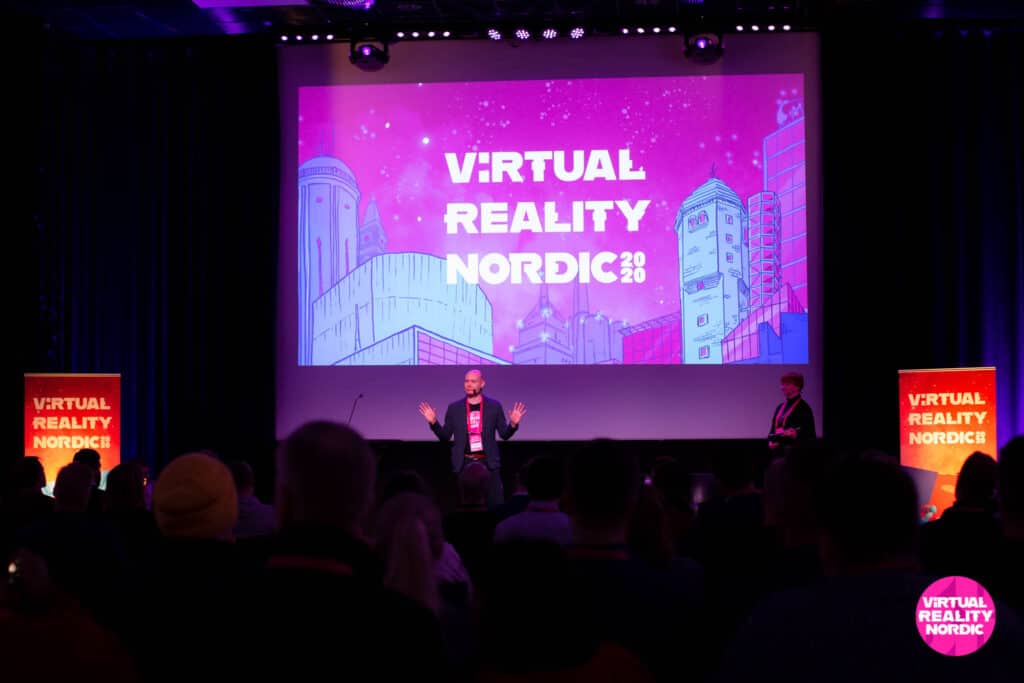Metaverse opens up for business
Game development has brought the virtual world to homes. The digitally native and global Gen Z has grown up with advanced graphics for computer games. Their experience and attitudes set high standards for the virtual user experience.
The Metaverse is the virtual world of the future. It is where people enjoy themselves, buy and work virtually. User simultaneity allows them to interact and communicate with each other in a shared virtual environment.
Metaverse and multisensory experiences
Virtuality creates new kinds of opportunities for business. The Metaverse offers customers a multi-sensory customer experience through virtual, real-time interaction.
Today, virtual reality (VR) in the metaverse is, for example, a commercial VR environment where customers can explore the products and services on offer in 3D showrooms or simulated use cases.
Customers create a virtual character for themselves, which allows them to move and chat with other virtual characters in the same space. The virtual 3D environment and models help the customer to get familiarised with the features of products and services and thus make it easier, for example, to make a purchase decision. A well-designed virtual tour reduces the customer’s product returns and the need for customer service.
VR technologies enabling the metaverse
Virtual applications enable a virtual experience of things, places, and situations that are currently inaccessible.
The goal of a VR application is to create a lifelike, virtual, customer experience, to the extent that it is appropriate. A good example of this is the Simboat VR application developed in collaboration between MeKiwi and XR Marine. The highlights of boating are present virtually, allowing the customer to discover a new boat model even before the ice starts to melt.
The technologies enabling the metaverse are AR (Augmented Reality) and VR (Virtual Reality) and the intermediate form MR (Mixed Reality). They are based on XR (Extended Reality).
In the AR experience, virtual content is connected to the real world with the help of an AR-supported application or browser. A familiar example for many is the Pokémon GO game. In it, the player searches for Pokémon characters that are connected to the real world. Additional information or instructions on a product or service that can be accessed via a QR code is also an AR experience.
In a VR application, the virtual environment is viewed with VR glasses that exclude the outside world. In the environment, you interact with objects manually or with VR controllers. Visuals, sounds, and interactions with the environment create an immersive VR experience.

The use of the metaverse is increasing
Hyper-realistic, shared and multi-sensory virtual worlds are on the rise. The most advanced virtual environments are for business and industry. The adoption of Metaverse in the consumer market requires advances in devices, applications, platforms and connectivity.
According to Nashant Batra, Nokia’s Chief Strategy and Technology Officer, the first 5G-Advanced deployments will begin in 2025, when the coverage of the metaverse will increase dramatically. For more detailed technical information, see the guide Metaverse matters: A guide to an immersive future published by Nokia.
The metaverse is implemented by professionals
The aim of the VR experience is to achieve the immersiveness familiar from the gaming world, where the user is immersed in their VR experience. The aim is to create a VR environment in which the operating principles of the real world are reflected. A good example of a VR environment is MeKiwi’s latest VR game, Cave Digger 2: Dig Harder.
A positive user experience is created by skillful technical implementation and smooth service. The best results are achieved by a professionally multi-skilled product development team that includes software developers, graphic designers, UI/UX designers and service designers.
Want to boost your business with virtual reality? As professionals in game development and digital marketing and sales, we can help you make the most of virtual technology.
We will familiarise ourselves with your company’s needs and create an overall picture of the development project for you. We tell you what we do, how we move forward and what we achieve together.
We have been involved in the story of many customers. Check out the references and blogs on our website.
How to improve your website visibility?
You have web pages, but they don’t appear in your browser’s search results. This is a pretty common problem. It is often assumed that the marketing effort has been made once the website has been launched. Websites must be kept alive. They need updating from time to time, e.g. new content and internal and external linking.
How to do SEO?
SEO (Search Engine Optimization) is a process that improves the website visibility in relation to competitors’ ones. Website visibility is affected by the technical functionality of the site, search engine optimized content, company brand awareness, and user personalization. Personalization can be increased, for example, through product suggestions and retargeted advertising to the user of the site. In this blog, we will focus on producing search engine optimized content.

What is search engine optimized content like?
It is worth thinking about what are the strategic customer groups. What kind of customers do you want to market the services to? Who are the potential customers? What kind of needs do they have?
On the other hand, what kind of needs do we have ourselves? What services do we want to provide? What kind of leads do we want to achieve? How are target groups informed about their own values and goals? How would organisations, unions and associations improve the recruitment of new members, for example? Based on these questions, you can already guess what kind of content should be on the website.
In addition to strategy and customer orientation, one of the goals of website design is the visibility of the pages, i.e. search engine optimized content. However, before producing content, you need to find the most common search terms, i.e. keywords.
How to find keywords that work?
Keywords are the very words that customers use to find a solution to their needs. So step into the customer’s shoes yourself and start googling the service you want to find and know about. This allows you to find the best keywords and the most common questions that customers have used when searching for the service.
Customer orientation, natural questions, keywords and linking enhance the findability of the website. Search engine optimised keywords are not just a list of words in the content, they are embedded in the titles and text. The main thing is the clarity and interest of the text from the customer’s point of view.
The most important keyword is the one around which the content is built. Other keywords, on the other hand, support the topic substantially. You can’t fool the search engine, so you shouldn’t overuse keywords. A good ratio is one keyword per 20 words. Services are also often sought with questions. Questions are great keywords. They can be used in content titles. From the keywords you can create the so-called keyword map to help write the rest of the content.
Keywords and content writing
Keyword lists are not yet content, but pages should provide customers with expert and interesting content. It must also be salesy and support the customer’s path to purchase. The website may contain, for example, product information about products, test results and customer quotes about the use of the product. The content of the services includes service descriptions, pictures, maps, customer stories and customer quotes about the service. The sites of organisations etc. provide members with relevant information on their activities.
Whose job, then, is it to produce content? You can entrust content creation to professionals if you don’t have the time and know-how to do so. The professional knows how to write clear, interesting and sales-promoting text. However, you are a service provider and know more about your services than an outsider. Therefore, you should participate in content production as an expert, and provide information and comment on content produced by an outsider.
What is the meta description?
The website is made more interesting by the meta description, i.e. the metatext, which appears as text that describes the content of the web page when the browser’s search results are listed. The aim of the description is to capture your interest and make you want to explore the site in more detail.
The role of meta description is significant, so it is worth investing in it. The description is written in a customer-oriented manner. Let’s think about what a potential customer wants to know and consider the answers to them. The more interesting the description, the more likely it is that the customer will click on the site.
Is your search engine optimization up to date? As digital marketing experts, we can improve the discoverability of your business website.
We get acquainted with the technical implementation of your company’s website and the optimization of services and keywords. We create an overall picture of the development project for you, what we do, how we proceed and what we achieve together.
Read also our previous blog, How do I produce meaningful content?
Want to know more about external links? You can check the MOZ website.
How do I create meaningful content?
Content is always produced for the customer. It needs to reach the right customers and address them in the right way. Business strategy, brand and customer understanding are the cornerstones of content production. They give the content a strategic direction, a way of working and communicating, and create value for the customer. The key to meaningful content production are buyer personas, the purchase paths created for them, timely content and content linking from different channels to websites.
How do I strategically produce the right content?
Content marketing is part of a company’s marketing strategy. In the same way as the marketing strategy and the marketing plan that implements it, the content strategy and content production also follow the business strategy of the company. In this way, the organisation works in harmony towards the goals set.
Strategically, we know, for example, to whom, what, how and where we market and sell. From the perspective of a content strategy, it is meaningful to know what kind of buyer personas we want to reach, engage and serve, and how we manage content in different channels and websites. When content is created around the problems and goals of the buyer persona, sales grow, the brand is strengthened, and our company succeeds.
For the overall brand of the company, it is important that the communication is in line with the brand. The communication of brand identity and value proposition is reflected in all communication, so it should not be forgotten in content production either. The contents consistently reflect the company’s personality, way of working and communicating. Brand should manifest itself in all forms of communication, both visual and spoken content. Consistency of communication increases the credibility of the company in the eyes of the client.

How do I add customer focus to content production?
The better we understand the customer, the easier it is for us to produce content. Customer research provides valuable information for defining buyer personas and the factors that guide a purchase decision. The goal of customer orientation is to create value for the customer with every channel and content. Well-executed content is interesting, informative and motivating for the customer and supports the purchasing process. They also improve the interaction and cooperation between the customer and the company.
The content creator is particularly interested in the customers’ purchasing and service experiences. Purchasing services requires expertise and is often challenging for the customer. Customer satisfaction and efficient and profitable sales are best realised when the customer’s purchase path and the company’s sales path go hand in hand. The client is provided with useful content in a timely manner at different stages of the purchase path.
Customers can be provided with more relevant content that facilitates and speeds up the buying process. For example, a website can create a unique purchase path for each buyer persona. At the beginning of the customer’s purchase path, the task of content production is to support the findability of the website and the intelligibility of the content of the service descriptions. Content linking and search engine optimised content help the customer find the company’s services. The content of the website should provide information and support the customer in the purchase process. Meaningful content entices the customer to progress from one content to another and leads the customer towards a purchase decision.
Is your content creation relevant? At MeKiwi, we use service design to study customer experience and develop the digital purchase path. As digital marketing experts, we can help your company develop content production. We look at your company’s goals and needs. We create an overall picture of the development project for you, what we do, how we proceed and what we achieve together.
Web design trends for 2021
A good website is something every business should invest in. The purpose of the website is after all to attract visitors and generate the highest quality leads for the company. We collected a few web design trends for 2021.
Minimalism
It's good to start website design from a simple approach. The visitor should not be overwhelmed by shapes and colors, also in this case less is more. A clear and user-friendly layout serves the visitor more efficiently and the company's message can be clearly displayed.
Dark mode
Black or dark background is friendly and pleasing to the reader’s eye, which increases the likelihood of the reader enjoying the site and staying there longer. Light text on a dark background also stands out even better. Dark themes have also been used by big companies (e.g. Facebook), which website designers have also begun to adopt due to its popularity among users.
3D elements
Interactive 3D elements in website design is one of the rising slightly more unique trends. Such elements can be utilized, for example, in online stores, where the customer can examine the product throughout by rotating the product image on the screen. 3D elements can also be used non-interactively as a mere illustration.
Scroll effects
Perhaps the most popular scrolling effect is Parallax scrolling, although Parallax has been on the surface for a long time, it continues to be popular. In the parallax effect, elements on the page, such as the text in the foreground and the image in the background, move at different rates as the user scrolls the page. Scrolling effects can also use different animations when moving from one section of a page to another, such as zooming or horizontal scrolling. Various scrolling effects can bring more life to the site with very little effort without compromising the usability of the site.

MeKiwi can help your business by designing and implementing modern and functional websites. Contact us whether it is a small website update or a complete reconstruction.
Accelerate business growth with the innovation voucher
The Business Finland innovation voucher offers a quick way to test the sustainability of your innovation and study its market.
The innovation voucher is intended for the acquisition of expert services related to innovation activities. The maximum grant is 5,000 euros + VAT. with a 1000 euro + VAT self-financing contribution. A small aid is also provided by the payment procedure of the innovation voucher, in which the service provider invoices Business Finland directly.
Buy expertise with the innovation voucher
Business Finland's website states that the innovation voucher is intended for established SMEs that have a new product or service idea with international growth potential.
How does the innovation voucher help to develop an idea? In digital services, for example, service design or user interface demos are such limited entities that are suitable for funding with the innovation voucher. The innovation voucher can also be used to finance the development of a product and service strategy.
You should choose a service provider that complements your company’s expertise. This is how you get the most out of your innovation voucher.
MeKiwi has participated in many innovation voucher -projects
B.UP Oy is a personnel coaching company, which was founded in 2020. We have had the pleasure of creating a prototype of the B.UP wellness application, in which they received support from Business Finland's innovation voucher. In the project, we created the general look of the B.UP application and one research trip leading to self-development with reflection tasks. Read the full customer experience here.
MeKiwi is a service provider approved by Business Finland. We help our customers plan development projects according to each need and guide them in applying for BF innovation voucher financing. Contact Jonna and we will plan your innovation project!
How to make better performing newsletters
What is a successful newsletter? When you think of the word newsletter, what is the first thing that comes to your mind? Pop-up windows that ask to subscribe or email full of daily newsletters with the same headlines? Yes, it’s safe to say that not all people like newsletters, but they still exist, because there is a demand for those who can distinguish themselves. There are indeed many fish in the sea, but you want to make sure that you get picked. That is why we wanted to dive a little deeper and find out what will make newsletters perform better.

Use social media
Not only sending your newsletter to people via email, it should also be promoted utilizing your company’s social media channels. Remember to share the link to your newsletter and call-to-action to subscribe. Social media can also be used to get to know your audience better, it will help you to create more meaningful content for your readers and prompt the interest of those who are not yet familiar with your newsletter.
Better performing newsletters are simple and minimal
We bet that there are many interesting things happening in your company and you would just love to go and shout every single great news out to the public, but think about the busy reader trying to find the time to go through all your topics that might not even be interesting enough for them. So clean and simple is the way to go, you don’t want to drown your readers too much.
Consistent but unique
When you order something, you would most likely like to know what the product is about. Same goes with newsletters, in most cases keeping the content consistent will attract the best audience just for you and also keep them interested in your content in the future, since they know what is coming. Just add a little twist, to keep the content fun. Speaking of interesting and fun, to make better performing newsletters make sure that your main title varies in each newsletter. The more unique and eye-catching the title is, the more likely your post will be clicked.
Visual style of better performing newsletters
Aside from content itself, a simple and clean style can also be applied to the visual side of the newsletter. Think about the contrast of the colors, the text should be easily seen and read. The images should be high-quality images that reflect the content, they shouldn’t be just random stock photos.
Summary for better performing newsletters is consistent, fun and readable content with a spice of engaging titles and high-quality relevant images. You can always use your imagination to try out different things and find what works best for your company.
Signs of top-notch customer service
There is no business without customers and keeping good relations with them is vital for every company. Word-of-mouth advertising should not be underestimated, it affects your brand for better or worse. The brand of a company is built on how customers see it, not from how the company sees itself. A top-notch customer service covers how to provide the best possible customer experience.
Product knowledge inside and out
One essential point of delivering good service is the knowledge of the product. Think about someone trying to sell you something they know nothing about. That does not give a very good impression now, does it? Make sure your employees know the business, and what they are selling, to provide a better experience for the customer. Motivate employees to get to know the business and services more by arranging workshops or weekly meetings. After all, employees are the ones who represent your brand.
Step in the customer’s shoes
When you are presenting your products or services to the customer, they don’t want to hear what you do, they are interested in how they will benefit from your service. The best customer service highlights what you really can offer to their business in terms of value. When thinking about value, pricing the service right is one key point. Also make sure that the product or service is what you describe it to be.
Try seeing things from the customer’s point of view, listen to them carefully and together try to find just the right solution for them. You want to keep your clients happy and make them also want to come back. Treat your clients kindly and don’t talk down to them, no matter how hard the situation is. Don’t forget, communication is the key!
Keep the schedule in mind
A good customer experience involves good planning, so before your team storms into a new project make sure that the scheduling is done properly. Dividing tasks into smaller sprints gives everyone a better overview of what is going on and what is going to happen next. Deliver the project in time, you don’t want to make your client wait for too long. In case your company’s internal communication needs improvement, we already got you covered. Go check our post for tips onhow to make your company’s internal communication work.
Keep also communicating with your customers, be reachable and give updates how the project is progressing and provide them material along the way to get the feedback. Make the desired changes to meet the expectations, but bear in mind the budget, schedule and if the changes are possible overall. You are the expert of your field and the client doesn’t always know the best practices of how things are supposed to be done. It is your job to provide the correct information needed to keep the project on track.
Believe in client questionnaires
After you finish a project, send a satisfaction survey to the client to get immediate feedback. This ensures that you are going in the right direction with your customer service and helps to improve your business. You can utilize the given feedback to promote your brand and services.
Interact with your clients through social media
Last but not least, using social media effectively is a part of delivering good customer service. Publish content what targets your desired audience, what might answer their burning questions and get them motivated to contact you. Choose the right platforms for you and try to keep them active and be responsive in the comments.
The subjects on this post are only the tip of the iceberg but will help you create a more meaningful relationship with your customers.
Couldn't make it to the Virtual Reality Nordic 2020 Event? Here's the summary of what happened during the day
The Virtual Reality Nordic 2020 event organised in Oulu by MeKiwi Oy gathered nearly one hundred and fifty business representatives interested in the possibilities of VR technology and a number of industry experts.
The main venue of the event was the Aurora hall of the Hotel Lasaretti and the most enthusiastic guests had arrived well in advance. Samuel Kuosmanen, CEO of Mekiwi Oy, started the event with a welcome speech. After that, the energetic and charismatic Niina Karvinen took over as the event's host Niina is a business developer and influencer based in the Oulu region. Karvinen describes herself as an enthusiast who wants to help others succeed. In addition to her energy, many networking pods with a variety of services were used to make the day more enjoyable and create a special atmosphere for the whole event.

Virtual reality as a training environment
The first speaker of the day was Kim Härköki from Varjo Technologies Oy, who opened up the potential of VR technology, especially from a healthcare perspective. In healthcare, virtual reality is particularly used as an educational environment. Härkönen showed how surgeons practice complex and challenging open surgeries using virtual reality. The presentation highlighted the importance of changing the world by working together and using modern technology.
After Härkönen, there was the first keynote speaker of the day. Sami Heinonen from Zoan, who calls himself XR Evangelist, highlighted the added value of virtual reality across different business areas. Heinonen's presentation included many visually impressive demos and he convinced the audience of the potential of XR technologies.

After a networking break, Pekka Ouli from the vocational school of North Central Finlandtook the stage. He told the audience about advanced digital learning environments and how virtual reality enables completely new dimensions in learning. After Ouli, the stage was taken over by Jonas Rajanto (Grape People Finland). Rajanto gave an in-depth presentation on the benefits of VR technology for distance learning. Remote virtual meetings are similar to face-to-face meetings. Among other things, they make it easier to assess the emotional states of the participants and thus lead to more genuine interaction. The highlight of Rajanto's presentation was definitely the live demo, in which he was joined by a few brave visitors to the event. The demo was a great demonstration of how the virtual meeting increased the cohesion and focus of the participants on the topic at hand.
After a rich buffet lunch and networking, the programme continued in the Aurora hall. Tommi Teronen from Teatime Research gave a presentation on solutions for the cultural and entertainment sector. Iikka Finning from Nokia explained how they use VR technology in research and Orkun Ceylan from 3D Talo presented a VR solution in use at Ponsse. Before the second keynote speaker of the day, Jani Kaipainen, founder of MeKiwi, speculated on the future of artificial intelligence with its opportunities and threats. In the afternoon, there was also the opportunity to participate in workshops organised by Oulu University of Applied Sciences in connection with the VIRTU project. The workshops explored Teatime Research's immersive cultural experiences and Glue's virtual reality platform that allows users to collaborate remotely.
Addressing future challenges
The final speaker of the day before the panel discussion was the second keynote speaker of the event, who many in the audience had specifically gathered to listen to. Steven LaValle from the University of Oulu, a pioneer in virtual reality and robotics, did not disappoint this time either. He summed up the essentials nicely. LaValle sees the key to success as a constant desire to learn and the ability to accept critical feedback. Solving the challenges of the future requires cooperation. Bold testing of ideas and openness will take us step by step forward, LaValle concluded. The Virtual Reality Nordic event ended with an interesting panel discussion, led by the usual moderator, Karvinen. The panel included Kim Härkönen from Varjo, Begum Dogan from MeKiwi, Natasha Skult from MiTale and Steven LaValle from the University of Oulu.
The wonderful day included a wealth of VR-related case studies from the business world. Visitors also had the opportunity to try out the latest VR solutions in the form of demos provided by exhibitors. The day also included interesting workshops to solve practical challenges using virtual reality.
The presentations at the event showed that VR technology has come a long way and the use cases have diversified. It is clear thatvirtual reality is here to stay. It continues to grow in popularity and there is no reason to doubt that it will continue to grow as technology advances and the price of virtual glasses falls. Virtual Reality Nordic 2020 demonstrated with practical examples how VR technology brings many benefits as a design tool, an educational environment, a marketing enabler and an enabler of remote viewing.
Creating innovation together
In November, MeKiwi participated in the Innovation Bootcamp in Pokhara, Nepal, which aimed to create new innovations for local needs. The event was organised by the Tribhuvan University (Institute of Engineering) in cooperation with the Nepal Go Association, an association founded in Oulu to promote education and employment in Nepal. The project was funded by the Gandaki provincial administration, and Mukti Paudel from Nepgo ry was the project leader for both countries.
Nepgo ry invited Finnish companies to participate in the event to mentor students and solve challenges together. MeKiwi was excited by the idea and decided to participate. From Finland came also Raimo Korhonen from KeepLoop, Kimmo Paajanen from OAMK and two guest lecturers, Janne Korhonen, PhD consultant from Aalto University and Anu-Maria Laitinen, knowledge management consultant.
The five-day event took place on the Paschimanchal campus. In addition to the invited companies, the event was attended by around 30 students and experienced local mentors, each with extensive knowledge of the issues at hand.
Challenges and ceremonies
The event started with a formal welcome ceremony on campus in honour of the guests. The mayor of the city and a local minister were also invited. During the ceremony, the guests were given flowers and were dressed in colourful Nepali headdresses. The morning was full of celebrations, as was the evening of the last day of the event.
The Bootcamp itself started with six different challenges to which the university students had to develop a solution together with representatives of companies. MeKiw was tasked to create a report on the level of digitalisation in Nepal, both on the business and education side. In addition to the report, the team looked at how to get parents more involved in their children's studies. As a solution, a "Wilma" type service, which we are also familiar with, was proposed. The mayor immediately agreed to pilot-test 10 schools, but full commercialisation of the service is a prerequisite for real implementation.
Again next year?
Samuel Kuosmanen, CEO of MeKiwi, was very pleased with the quality of the event. MeKiwi's goal for this trip was to identify business opportunities, build a network and identify local expertise. All these elements were implemented beyond expectations.
"I would definitely go again, as long as the trip is well planned in terms of purpose and appointments. It took a surprisingly long time to travel, but an international airport is being built in Pokhara, which will speed up travel in the future," Samuel summed up when asked if he would go again.
About Nepal
Nepal is a poor developing country surrounded by mountains, where more than 50% of the population lives on less than a dollar a day. Although people come from very simple backgrounds, they are very welcoming. The mountains have kept trade very limited with countries such as India and China. Recently, there has been a wake-up call on this issue and there is now a strong push for change. Tourism has played its part in boosting development and growth prospects are already looking bright. This will also create new opportunities, for example for Finnish educational exports and other cooperation. Now is therefore a very good time to invest in Nepal.
Selling one thing is the first step to sell another
There are many steps involved in developing a good digital product. Organizing user testing and collecting user data are important stages that should be handled properly. Good networks help with this, too.
Cooperation produces better innovations. A technological collaboration in particular helps the likelihood of a small business succeeding in innovation. Still, some studies show that small firms have fewer innovation cooperation than large firms.
Earlier this year, we published a blog about how the principles of open innovation have benefited MeKiw’s development and growth. As we have been asked a lot about this topic, we will publish a series of three blogs where we explain on a practical level how we implement innovation cooperation.
Previously we have covered the search for a business opportunity and the stage of project implementation. In this part, we'll talk about the collaborations in the user testing and publishing phases.
Each development team is blind to their own work
Product testing already starts in the project phase, which we described in the previous part of this blog series. Testing of all digital products must be carried out in many stages and in different ways. There is no known public, continuously available service for user testing, but by being active and staying informed, opportunities may arise. Participation in the Edudigi project enabled MeKiwi to test the VR game in Oulu's Tietomaa. However, most of the testing is organised in-house. You need networks for that too.
"Influencers are important contacts with ordinary consumers," says Begum Dogan.
Influencers are used to reach active players, but you also want people with no previous gaming experience to become testers. The flaws in the game are found because they do not know how to adapt to them.
Each development team is blind to its own game and can't see its weaknesses", points out Begum Dogan.
In addition to reaching testers, other contacts are needed. A third party brings its vision and ideas to the collaboration. It gives a perspective on things when you can easily be too focused to notice.
The gaming marketing company Kuvion complements MeKiwi's marketing team. Kuvion is deeply integrated in the marketing of Cave Digger, a game published by MeKiwi on VR platforms. "In this partnership, everyone is in charge," says Begum Dogan. "The friends at Kuvion take care of VR Cave Digger as if it was their own".
Wishing for a B2B meeting place in Oulu
An important channel for MeKiwi to get feedback on the released product has been the export trips organised by BusinessOulu to key markets in the games industry. While showcasing a published product, it also lays the groundwork for new projects. Developing a game for the international consumer market builds internal expertise and networks that also benefit the domestic market.
"Aatu Numminen, VR and B2B Customer Relationship Manager at MeKiwi, expects the opening of the BusinessAsema in Hallituskatu to create a positive environment for cooperation. ”I hope it will be a B2B meeting place, similar to what the Pelikampus is for the companies in the gaming sector"
"I like the pop-up idea. I could very well go there to present our VR entertainment games production," Numminen envisions. "People might well come up with new ideas. Then it's just a matter of planning how to implement them."
Research background
MeKiwi was one of the companies surveyed in a study conducted as part of the Innovation Alliance's Accelerating Operations project, which also included a master's thesis entitled “The Innovation Process of a Startup Company in a Regional Innovation Cluster”. The key finding of the study was that start-ups can benefit from the regional innovation ecosystem at all stages of their innovation process, both by using innovation support services and by establishing meaningful networking relationships. The study divided the innovation process into three stages according to the customer-driven Design Thinking innovation process model. In this series of three blogs, we describe how we implemented the principles of open innovation in line with these three stages.
Sources:
- Brown, T. (2009). Change by design: How design thinking can transform organizations and inspires innovation. New York (N.Y.): HarperBusiness.
- Chesbrough H. (2003) The era of open innovation. MIT Sloan Management Review; 44:35–41
- Crossan, M & Apaydin, M. (2010). A Multi-Dimensional Framework of Organizational Innovation: A Systematic Review of the Literature. Journal of Management Studies, 47(6), 1154–1191.
- Freel, M. S. (2005). Patterns of Innovation and Skills in Small Firms. Technovation, 25(2), 123–134.
- Nieto, M. J. (2010). Technological Collaboration: Bridging the Innovation Gap between Small and Large Firms. Journal of Small Business Management, 48(1), 44–69.
- Parida, V., Westerberg, M. ja Frishammar, J. (2012). Inbound Open Innovation Activities in High-Tech SMEs: The Impact on Innovation Performance. Journal of Small Business Management 2012 50(2), 283–309.
- Rogers, M. (2004). Networks, Firm Size and Innovation. Small Business Economics, 22, 141–153.
- Sydänmaanlakka, P. (2009). Jatkuva uudistuminen: Luovuuden ja innovatiivisuuden johtaminen.Hämeenlinna. Talentum Media Oy. 293 s.



























